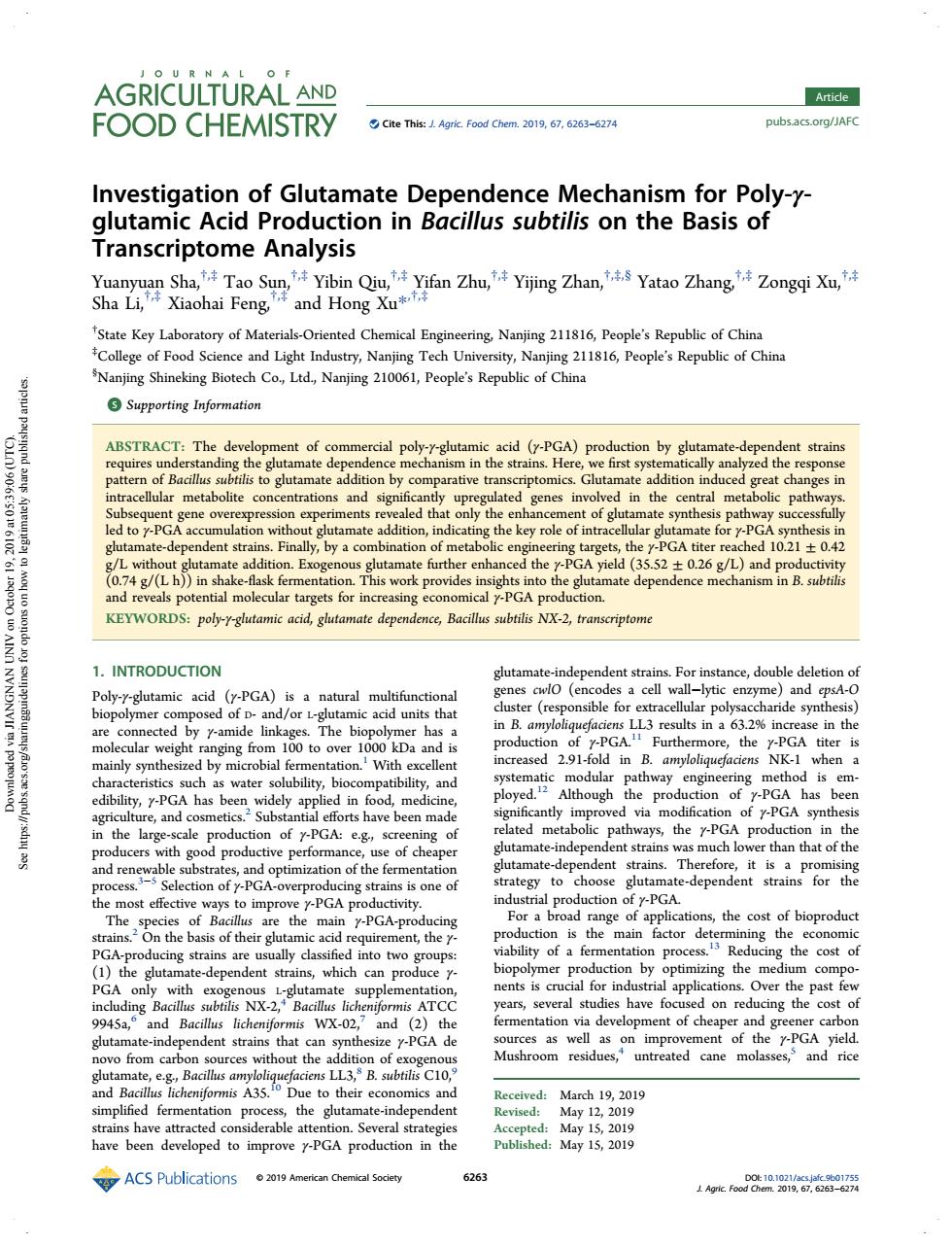正在加载图片...

AGRICULTURAL AND Article FOOD CHEMISTRY Cie This:Agrie Food Chem.19,7,63-27 pubs acs.ora/JAFC Investigation of Glutamate Dependence Mechanism for Poly-y- glutamic Acid Production in Bacillus subtilis on the Basis of Transcriptome Analysis Xiaohai Feng, State Key Laboratory of Materials-Oriented Chemical Engineering Nanjing 1 People's Republic of Chin College of Food Science and Light Industry,Nanjing Tech University,Nanjing 211816,People's Republic of China Nanjing Shineking Biotech Co.,Ltd.,Nanjing 210061,People's Republic of China Supporting Information ent of c ction by glutan the glutamate d e first sy ges I led th ctncntoofghtanmai elutamate-dependent strai erin PGA titer n 1ed1021±0.4 and reveals potential molecular targets for increasing economical y-PGA production. KEYWORDS:poly-y-glutamic acid,glutamate dependence,Bacillus subtilis NX-2,transcriptome 1.INTRODUCTION glutamat a cell a enzyme) of D- mic acid units that in B.an ight' 291-fold in B.amylo rmore,the With excellen NK-I nainly synthesized by microbial fe eering method is pro on of has e,and efforts have been ma related metabolic pathw ays,the y-PGA production in the much l than that of th Th andrenewgbleabstatespndcoptimiationofthefementatie egy to hoose glutamate-dependent strains forth ction of cations.the cost of bioproduc tior is the mai ctor dete ng the economi GA- oducing strain euaye into two s,which can meg the cost of s is cru ial for ind pplications. Over the past fe ng t cost o 56 ndent well as on imp nent oft y-PGA yield ovo from carbor urces without the Mushroom untreated can mo and nice March 19,2019 plihed fermenta the glutamate-independen May 12,2 to in -PGA roduction in the PaMy12019 ACS Publications 010A 636 1AkoamCR28a6to2Investigation of Glutamate Dependence Mechanism for Poly-γ- glutamic Acid Production in Bacillus subtilis on the Basis of Transcriptome Analysis Yuanyuan Sha,†,‡ Tao Sun,†,‡ Yibin Qiu,†,‡ Yifan Zhu,†,‡ Yijing Zhan,†,‡,§ Yatao Zhang,†,‡ Zongqi Xu,†,‡ Sha Li,†,‡ Xiaohai Feng,†,‡ and Hong Xu*,†,‡ † State Key Laboratory of Materials-Oriented Chemical Engineering, Nanjing 211816, People’s Republic of China ‡ College of Food Science and Light Industry, Nanjing Tech University, Nanjing 211816, People’s Republic of China § Nanjing Shineking Biotech Co., Ltd., Nanjing 210061, People’s Republic of China *S Supporting Information ABSTRACT: The development of commercial poly-γ-glutamic acid (γ-PGA) production by glutamate-dependent strains requires understanding the glutamate dependence mechanism in the strains. Here, we first systematically analyzed the response pattern of Bacillus subtilis to glutamate addition by comparative transcriptomics. Glutamate addition induced great changes in intracellular metabolite concentrations and significantly upregulated genes involved in the central metabolic pathways. Subsequent gene overexpression experiments revealed that only the enhancement of glutamate synthesis pathway successfully led to γ-PGA accumulation without glutamate addition, indicating the key role of intracellular glutamate for γ-PGA synthesis in glutamate-dependent strains. Finally, by a combination of metabolic engineering targets, the γ-PGA titer reached 10.21 ± 0.42 g/L without glutamate addition. Exogenous glutamate further enhanced the γ-PGA yield (35.52 ± 0.26 g/L) and productivity (0.74 g/(L h)) in shake-flask fermentation. This work provides insights into the glutamate dependence mechanism in B. subtilis and reveals potential molecular targets for increasing economical γ-PGA production. KEYWORDS: poly-γ-glutamic acid, glutamate dependence, Bacillus subtilis NX-2, transcriptome 1. INTRODUCTION Poly-γ-glutamic acid (γ-PGA) is a natural multifunctional biopolymer composed of D- and/or L-glutamic acid units that are connected by γ-amide linkages. The biopolymer has a molecular weight ranging from 100 to over 1000 kDa and is mainly synthesized by microbial fermentation.1 With excellent characteristics such as water solubility, biocompatibility, and edibility, γ-PGA has been widely applied in food, medicine, agriculture, and cosmetics.2 Substantial efforts have been made in the large-scale production of γ-PGA: e.g., screening of producers with good productive performance, use of cheaper and renewable substrates, and optimization of the fermentation process.3−5 Selection of γ-PGA-overproducing strains is one of the most effective ways to improve γ-PGA productivity. The species of Bacillus are the main γ-PGA-producing strains.2 On the basis of their glutamic acid requirement, the γ- PGA-producing strains are usually classified into two groups: (1) the glutamate-dependent strains, which can produce γ- PGA only with exogenous L-glutamate supplementation, including Bacillus subtilis NX-2,4 Bacillus licheniformis ATCC 9945a,6 and Bacillus licheniformis WX-02,7 and (2) the glutamate-independent strains that can synthesize γ-PGA de novo from carbon sources without the addition of exogenous glutamate, e.g., Bacillus amyloliquefaciens LL3,8 B. subtilis C10,9 and Bacillus licheniformis A35.10 Due to their economics and simplified fermentation process, the glutamate-independent strains have attracted considerable attention. Several strategies have been developed to improve γ-PGA production in the glutamate-independent strains. For instance, double deletion of genes cwlO (encodes a cell wall−lytic enzyme) and epsA-O cluster (responsible for extracellular polysaccharide synthesis) in B. amyloliquefaciens LL3 results in a 63.2% increase in the production of γ-PGA.11 Furthermore, the γ-PGA titer is increased 2.91-fold in B. amyloliquefaciens NK-1 when a systematic modular pathway engineering method is employed.12 Although the production of γ-PGA has been significantly improved via modification of γ-PGA synthesis related metabolic pathways, the γ-PGA production in the glutamate-independent strains was much lower than that of the glutamate-dependent strains. Therefore, it is a promising strategy to choose glutamate-dependent strains for the industrial production of γ-PGA. For a broad range of applications, the cost of bioproduct production is the main factor determining the economic viability of a fermentation process.13 Reducing the cost of biopolymer production by optimizing the medium components is crucial for industrial applications. Over the past few years, several studies have focused on reducing the cost of fermentation via development of cheaper and greener carbon sources as well as on improvement of the γ-PGA yield. Mushroom residues,4 untreated cane molasses,5 and rice Received: March 19, 2019 Revised: May 12, 2019 Accepted: May 15, 2019 Published: May 15, 2019 Article Cite This: J. Agric. Food Chem. 2019, 67, 6263−6274 pubs.acs.org/JAFC © 2019 American Chemical Society 6263 DOI: 10.1021/acs.jafc.9b01755 J. Agric. Food Chem. 2019, 67, 6263−6274 Downloaded via JIANGNAN UNIV on October 19, 2019 at 05:39:06 (UTC). See https://pubs.acs.org/sharingguidelines for options on how to legitimately share published articles